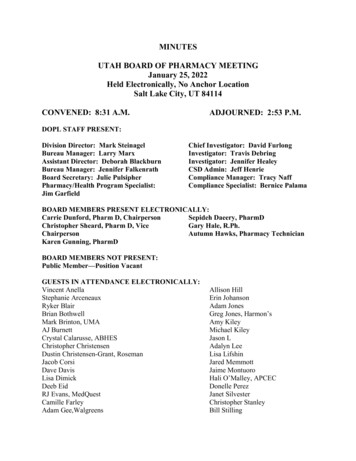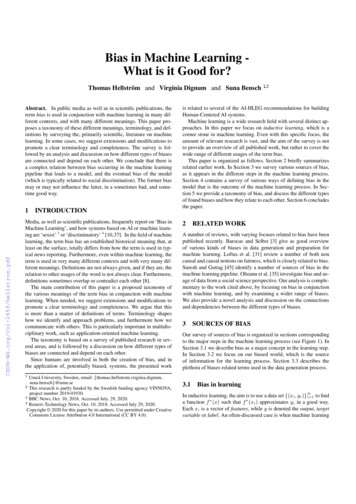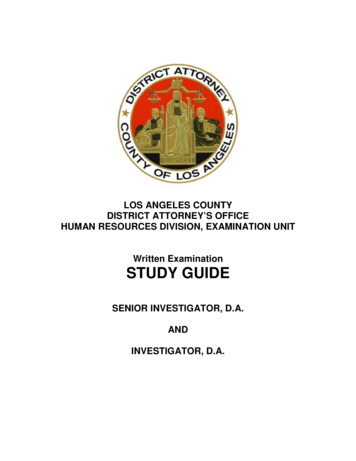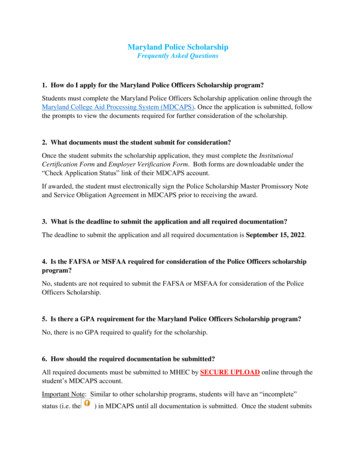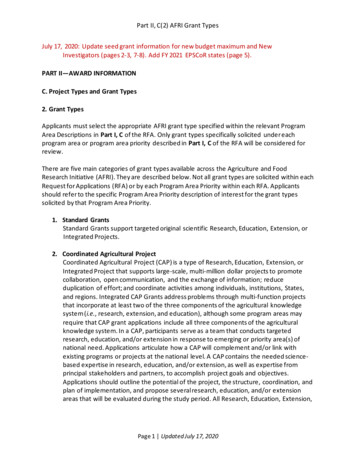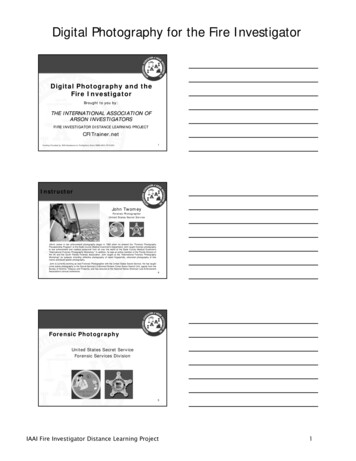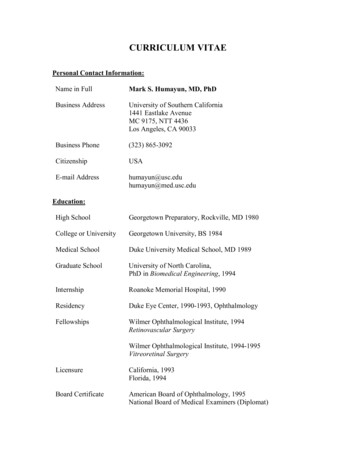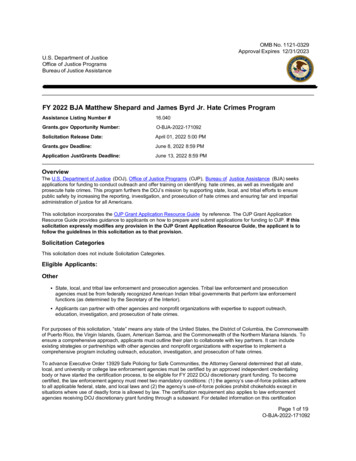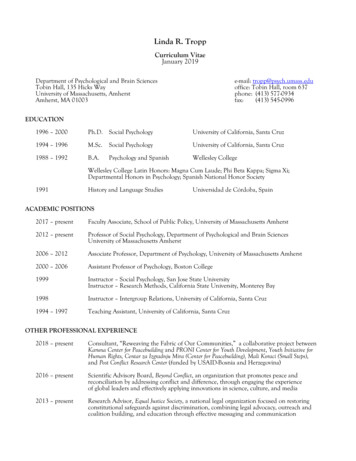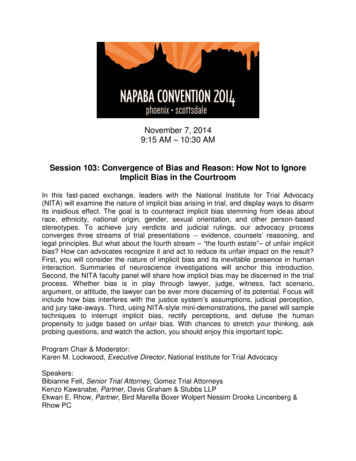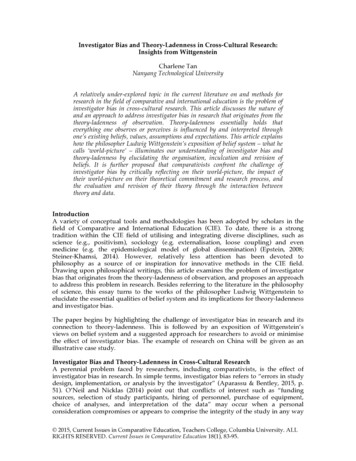
Transcription
Investigator Bias and Theory-Ladenness in Cross-Cultural Research:Insights from WittgensteinCharlene TanNanyang Technological UniversityA relatively under-explored topic in the current literature on and methods forresearch in the field of comparative and international education is the problem ofinvestigator bias in cross-cultural research. This article discusses the nature ofand an approach to address investigator bias in research that originates from thetheory-ladenness of observation. Theory-ladenness essentially holds thateverything one observes or perceives is influenced by and interpreted throughone’s existing beliefs, values, assumptions and expectations. This article explainshow the philosopher Ludwig Wittgenstein’s exposition of belief system – what hecalls ‘world-picture’ – illuminates our understanding of investigator bias andtheory-ladenness by elucidating the organisation, inculcation and revision ofbeliefs. It is further proposed that comparativists confront the challenge ofinvestigator bias by critically reflecting on their world-picture, the impact oftheir world-picture on their theoretical commitment and research process, andthe evaluation and revision of their theory through the interaction betweentheory and data.IntroductionA variety of conceptual tools and methodologies has been adopted by scholars in thefield of Comparative and International Education (CIE). To date, there is a strongtradition within the CIE field of utilising and integrating diverse disciplines, such asscience (e.g., positivism), sociology (e.g. externalisation, loose coupling) and evenmedicine (e.g. the epidemiological model of global dissemination) (Epstein, 2008;Steiner-Khamsi, 2014). However, relatively less attention has been devoted tophilosophy as a source of or inspiration for innovative methods in the CIE field.Drawing upon philosophical writings, this article examines the problem of investigatorbias that originates from the theory-ladenness of observation, and proposes an approachto address this problem in research. Besides referring to the literature in the philosophyof science, this essay turns to the works of the philosopher Ludwig Wittgenstein toelucidate the essential qualities of belief system and its implications for theory-ladennessand investigator bias.The paper begins by highlighting the challenge of investigator bias in research and itsconnection to theory-ladenness. This is followed by an exposition of Wittgenstein’sviews on belief system and a suggested approach for researchers to avoid or minimisethe effect of investigator bias. The example of research on China will be given as anillustrative case study.Investigator Bias and Theory-Ladenness in Cross-Cultural ResearchA perennial problem faced by researchers, including comparativists, is the effect ofinvestigator bias in research. In simple terms, investigator bias refers to “errors in studydesign, implementation, or analysis by the investigator” (Aparassu & Bentley, 2015, p.51). O’Neil and Nicklas (2014) point out that conflicts of interest such as “fundingsources, selection of study participants, hiring of personnel, purchase of equipment,choice of analyses, and interpretation of the data” may occur when a personalconsideration compromises or appears to comprise the integrity of the study in any way 2015, Current Issues in Comparative Education, Teachers College, Columbia University. ALLRIGHTS RESERVED. Current Issues in Comparative Education 18(1), 83-95.
Tan(p. 41). For example, a biased researcher might interpret study results in ways that favorthe funding agency (ibid). The focus of this essay is the effect of investigator bias thatoriginates from the theory-ladenness of observation.Theory-ladenness affects all researchers and applies to all disciplines. Theory-ladennessessentially holds that everything one observes or perceives is influenced by andinterpreted through one’s existing beliefs, values, assumptions and expectations.Philosophers of science, in particular, Norwood Hanson (1958), Paul Feyerabend (1969)and Thomas Kuhn (1962) contend that our observational evidence, far from beingtheory-neutral, is shaped by our paradigms and theoretical commitments (Bogen, 2014).Heidelberger (2003) highlights two forms of theory-ladenness: psychological andconceptual. The former refers to the psychological law that human perception is alwaysguided by prior beliefs and expectations; the latter foregrounds the prior theories heldby researchers by asserting that “the meaning of the observational terms involveddepends upon the theoretical context in which they occur” (ibid., p. 138).The phenomenon of theory-ladenness affects not just research in natural sciences butalso that in the social sciences, including the field of CIE (for further discussion ontheory-ladenness in natural and social sciences, see Hunt, 1994; Brewer & Lambert,2001). The Japanese comparativist Takayama (2011) claims that “any representativework necessarily reflects the researcher’s subjective positionality which privileges givenvoices and excludes others” (p. 461). Comparativists are especially susceptible toinvestigator bias since they bring with them not only their subjective positionality butalso their own cultural worldview and presuppositions that may differ from or evenclash with those under study. Investigator bias is particularly relevant to research onpolicy borrowing where “scholars in policy transfer research tend to draw fromeducation systems in the First World to make generalizations on policy borrowing andlending in the rest of the world” (Steiner-Khamsi, 2006, p. 675; also see Carney, Rappleye& Silova, 2012; Wiseman, Astiz & Baker, 2013). Such generalisations may promote ‘crosscultural cloning’ and ‘false universalism’ where the researchers – who themselves weresocialized into and/or trained in the education systems in the First World – impose theirown paradigms on the subject they are studying in a different cultural context (Nguyenet al., 2009).It is important to note that theory-ladenness is not an all-or-nothing phenomenon butinstead comes in various degrees. Without entering into discussion of the complexitiesinherent in and overlaps between labels, we may identify two main types of theoryladenness that occupy two ends of a spectrum: a radical/strong version and weakversion. The radical or strong version of theory-ladenness claims that all our observationsare influenced by and interpreted through our existing worldview to such an extent thatit is impossible for us to objectively evaluate the significance of an observation for atheory. This extreme form of theory-ladenness, according to philosophers such asHanson (1958) and Kuhn (1962), gives rise to incommensurability in research: theposition that we cannot compare experimental results because these results reside indifferent paradigms that ascribe different and incompatible theory-laden meanings andobservation language to the results (Franklin et al., 1989).Contrasting with the radical/strong version is a weak version of theory-ladenness thatholds that our observations, although influenced by and interpreted through ourexisting paradigm, are open to objective evaluation and revision. Focusing on this formof theory-ladenness, Freeman and Smith (1996) conclude from their empirical researchthat there is no “complete subordination of observation to the demands of prior theory”since “data can have an evidential impact on the credibility of a theory even when the84 Current Issues in Comparative Education
Investigator Bias and Theory-Ladenness in Cross-Cultural Researchobservations in question are influenced by the theory” (p. 326). In other words, ourperceptions are jointly influenced by the objective relations in the observational data andour prior theories. It follows that theory-ladenness, at least in its less extreme forms,does not necessarily pose a problem for researchers, since the researcher’s priortheoretical commitments are potentially open to evaluation and revision. Theoryladenness is only detrimental to research if it results in investigator bias – where theresearcher imposes one’s existing beliefs, values, assumptions and expectations on theresearch subject, ignores the evidential impact of data (especially evidence thatcontradicts one’s expectations), and draws conclusions that are aimed at reinforcingone’s ideological preferences.Some scholars have suggested reducing the effect of investigator bias throughtriangulation of research findings (e.g. see van Maanen, 1983; Miles & Huberman, 1994;Merriam, 1998; Shenton, 2004). But triangulation, although helpful, is insufficient as aresearcher may still observe and interpret the data obtained from different sourcesthrough theoretical assumptions and biases. In other words, triangulation, in itself, doesnot address the root cause of investigator bias: the influence of the researcher’spresuppositions, convictions and expectations on one’s research that leads to errors inthe inquiry process and outcome. What is needed is a deeper understanding of howinvestigator bias occurs and how it can be avoided or at least minimized by theresearcher.Wittgenstein on Belief SystemThe writings of Wittgenstein are pertinent to our topic as his exposition of belief systemcontributes to our understanding of the nature of beliefs, belief acquisition, and therelationship between belief system, theory-ladenness and investigator bias. Wittgenstein(1889–1951) was an influential twentieth century philosopher whose works have a majorimpact on the development of modern philosophy. Space constraint means that anexploration of Wittgenstein’s views, including their diverse interpretations andcontroversies, will receive less discussion than they deserve (for an in-depth analysis ofWittgenstein’s views in the context of philosophy and education, see the collection ofessays in Smeyers & Marshall, 1995). This article shall concentrate on his views takenfrom the book On Certainty (Wittgenstein, 1969) where the discussion was situatedagainst a backdrop of a philosophical debate on skepticism.Wittgenstein begins by observing that a person’s “convictions do form a system, astructure” (On Certainty, # 102, all subsequent citations are taken from this book, unlessotherwise stated). By referring to a system or structure, Wittgenstein reminds us thatbeliefs do not exist in isolation but find coherence and support within a web of beliefs.He elaborates, “When we first begin to believe anything, what we believe is not a singleproposition, it is a whole system of propositions” (# 141, 142, italics in the original). Hecalls this system or structure a ‘world-picture’ or “my picture of the world” (# 94). Aworld-picture comprises “the substratum of all my enquiring and asserting” (# 162) and“the matter-of-course foundation” of one’s research (# 167). To explain the dominationof a world-picture, Wittgenstein gives the example of chemist Antoine-LaurentLavoisier:Think of chemical investigations. Lavoisier makes experiments withsubstances in his laboratory and now he concludes that this and thattakes place when there is burning. He does not say that it might happenotherwise another time. He has got hold of a definite world-picture – notof course one that he invented: he learned it as a child. I say world-pictureCurrent Issues in Comparative Education 85
Tanand not hypothesis, because it is the matter-of-course foundation for hisresearch and as such also goes unmentioned. (# 167)It is instructive that Wittgenstein distinguishes between a world-picture and ahypothesis. The latter is “something to test by experience” whereas the former is “a ruleof testing” (# 98). In other words, a world-picture cannot be empirically tested and is“the inherited background against which I distinguish between true and false[hypotheses]” (# 94).Wittgenstein alludes to theory-ladenness when he asserts, “All testing, all confirmationand disconfirmation of a hypothesis takes place already within a system” (# 105, italicsadded). A world-picture encompasses the beliefs, values, assumptions and expectationsof a researcher that determine one’s observations, perceptions and interpretation of data.In the case of Lavoisier, his conclusion that “this and that that takes place when there isburning” is theory-laden in the sense that it is influenced by his prior world-pictureconcerning chemical compounds. Wittgenstein’s concept of world-picture helps us tounderstand why observational evidence is not theory-neutral but inevitablycircumscribed by and interpreted through an existing worldview. The notion of worldpicture also explains why the theory-ladenness of observation is both psychological andconceptual: we are mentally and emotionally inclined to rely on our existing worldpicture for all our observations and perceptions, and our prior theoretical commitmentwhich is grounded in our world-picture determines the meaning of observational termsfor our research.Another example by Wittgenstein demonstrates the pervasiveness of theory-ladenness,this time (ironically) for Wittgenstein himself. The example involves an adult telling achild that he has been to the moon. The child believed in the adult and proceeded to tellanother adult about it. Pointing out the absurdity of the claim made by the first adult,the second adult told the child that what the first adult said was “only a joke, the manhadn't been on the moon; no one has ever been on the moon; the moon is a long way offand it is impossible to climb up there or fly there” (# 106). Wittgenstein adds that thechild, upon hearing this, would not ordinarily stick to such a belief and would soon beconvinced by what the second (or any other) adult told him (ibid.). It is a significantpoint that this example was written by Wittgenstein in 1950-1951 before NeilArmstrong’s historic mission to the moon on July 20, 1969. Hence it is understandablewhy Wittgenstein himself dismissed the claim that some adult had been to the moon.Wittgenstein’s own world-picture of the impossibility of human beings setting foot onthe moon exemplifies theory-ladenness: it shapes his interpretation and judgementregarding the reasonableness of the before-mentioned claim at the time of his writing.On the question of how beliefs are acquired, Wittgenstein likens belief inculcation tolearning a game. He posits that propositions describing a world-picture function like“rules of a game” that “can be learned purely practically, without learning any explicitrules” (# 95). He avers that human beings do not learn the practice of making empiricaljudgments by learning rules; rather, we are taught “judgments and their connection withother judgments” (# 140). Wittgenstein’s point is that human beings acquire beliefsspontaneously through social practice rather than rule-learning. Put otherwise, we areinitiated and socialised into the world-picture of the community that we belong to. Thenatural and continuous existence of world-picture accounts for the inescapable andpermeating impact of theory-ladenness for human beings. The world-picture, with itstotality of beliefs, values, assumptions and expectations, becomes our “inheritedbackground” (# 94) for all our convictions and actions.86 Current Issues in Comparative Education
Investigator Bias and Theory-Ladenness in Cross-Cultural ResearchWittgenstein’s distinction between two types of beliefs within the world-picture furtherilluminates the characteristics of theory-ladenness:The child learns to believe a host of things. I.e. it [sic] learns to actaccording to these beliefs. Bit by bit there forms a system of what isbelieved, and in that system some things stand unshakeably fast andsome are more or less liable to shift. What stands fast does so, not becauseit is intrinsically obvious or convincing; it is rather held fast by what liesaround it. (# 144)The two types of beliefs are beliefs that are liable to shift and those that standunshakeably fast. Wittgenstein uses the analogy of sand and hard rock on the bank of ariver to underscore the difference between the two types of beliefs. Beliefs that are liableto shift are like the sand that gets washed away or deposited, whereas beliefs that standunshakeably fast are like the hard rock that is “subject to no alteration or only to animperceptible one” (# 99). The two types of beliefs are not dichotomous or immutable.Wittgenstein states that “there is not a sharp division” between the two types of beliefsand that “the river-bed of thoughts may shift” (# 97). He adds that “fluid propositions”[beliefs that are liable to shift] may be “hardened” while the “hard ones” [beliefs thatstand unshakeably fast] may become “fluid” (# 96).The two types of beliefs account for the two versions of theory-ladenness mentionedearlier: radical/strong and weak. A researcher whose theoretical commitment restsprimarily upon beliefs that stand unshakeably fast is likely to be vulnerable to theradical/strong version of theory-ladenness, whereas another researcher whosetheoretical commitment is premised largely on beliefs that are liable to change is moreprone to the weak version of theory-ladenness. In the case of the radical/strong versionof theory-ladenness, incommensurability of experimental results may arise if two ormore researchers subscribe to competing theories that are both underpinned by beliefsthat stand unshakeably fast. In such a situation, the competing theories shape therespective researchers’ perceptions, resulting in mutually incompatible theory-ladenmeanings and observation language for the same set of data. In contrast,incommensurability of experimental results is less likely to take place if at least oneresearcher subscribes to the weak version of theory-ladenness; the presence ofunderlying beliefs that are liable to shift allows the possibility for that researcher’stheory to be questioned and modified.It is important to note that a world-picture is not unchanging and unchangeable.Wittgenstein maintains that “what men consider reasonable or unreasonable alters” (#336) and that “a language-game does change with time” (# 256). A language-game,according to Wittgenstein (1953), consists of “language and the actions into which it iswoven" that is supported by a world-picture (Philosophical Investigations, # 7). Heexpands on the prospect of changing one’s language-game:Certain events would put me into a position in which I could not go onwith the old language-game any further. In which I was torn away fromthe sureness of the game. Indeed, doesn’t it seem obvious that thepossibility of a language-game is conditioned by certain facts? (# 617,italics in the original)Commenting on the above quote, Bax (2011) points out, “that On Certainty explainsworld pictures as open and dynamic does not only mean that it allows for difference anddivergence to occur naturally and accidentally; it also indicates what opportunities thereCurrent Issues in Comparative Education 87
Tanare for knowingly disengaging oneself, if only temporarily, from the world picture onehas inherited” (p. 136).But the possibility of critiquing and changing one’s world-picture does not mean thathuman beings can do so at will or immediately. Neither can one change anotherperson’s world-picture purely through rational means. Stressing the inadequacy ofusing reasons to convince someone to change his worldview, Wittgenstein avers that“[a]t the end of reasons comes persuasion” (# 612, italics in the original) – a process akinto conversion where we try “to give him our picture of the world” (# 262). In the processof revising one’s world-picture, “[s]ome practices will stay longer than other ones, and amedley-like mixture of discursive language-games constituting a world-picture is aproduct of a heterogeneous historical development” (Kober, 1996, p. 435). The organicand evolving attribute of world-picture gives rise to multiple world-pictures across subcommunities or sub-cultures within the same locality; they are all united by whatWittgenstein calls “family resemblance.” Using the example of members of a family, heexplains that “family resemblance” refers to “various resemblances between members ofa family: build, features, colour of eyes, gait, temperament, etc. etc. overlap and criescross in the same way” (Philosophical Investigations, # 67).A person’s world-picture provides the basis for such a person to make sense of andadjudicate between competing beliefs. Theory-ladenness implies that epistemic termssuch as knowledge, truth, evidence and rationality are undergirded and framed by one’sworldview or “totality of judgements” (# 140). Macmillan (1983) argues, “The picture,then is this: at the beginning there is training and more or less forceful impartation oflanguage and belief; the child is given a nest (OC 225) of convictions which stand fast forhim, which make possible the other modes of teaching within which rationality ispossible” (p. 369, italics added). Strawson (2000) concurs that we cannot help acceptingcertain beliefs as “defining the areas within which the questions come up of what beliefswe should rationally hold on such-and-such a matter” (pp. 39-40). Wittgenstein’s viewsparallel those of nineteenth century philosopher John Henry Newman (1890) whoasserts that all of us are governed by “antecedent assumptions” that stem from andreside in our tradition (Wittgenstein’s world-picture) on whose resources we draw.Antecedent assumptions include not only the taken-for-granted theories or systems ofthought, but also the accompanying concepts and attitudes, as well as the language inwhich they are expressed (Mitchell, 1997).It should be clarified that Wittgenstein’s exposition of belief system, in my view, doesnot necessarily imply or support epistemic relativism: the view that competing claimscannot be resolved from an objective and universally applicable standpoint since notionsof truth or rationality are totally determined by an individual’s belief system (worldpicture). Wittgenstein’s point is that one’s observations, interpretations and judgementsof reality are not ‘pure’ or immune from one’s world-picture. Although one’s worldpicture supplies the background information and presuppositions for that person’sunderstanding of the world, such an understanding remains open to external evaluationand subsequent revision, to varying degrees and in different ways, based on theinteraction between one’s theory and observational data.The interplay of theory and data is amplified in an example given by Wittgenstein on aresearcher’s investigation of physical objects. Wittgenstein notes that the researcher’sknowledge of the dimensions of a bridge depends on both the researcher’s calculation(i.e., observational data) as well as the researcher’s “assumption or a decision” (# 146)(i.e., theory). It is noteworthy that the dimensions of the bridge are not subjective orbiased – they exist in the external world and can be independently verified. However,88 Current Issues in Comparative Education
Investigator Bias and Theory-Ladenness in Cross-Cultural Researchthe dimensions make sense and are useful only when framed and supported by theinvestigator’s background knowledge and assumptions of the earth and other physicalobjects. A meaningful calculation of the dimensions of the bridge, for instance,presupposes that an external world exists and that the measurements of physical objectssuch as the bridge remain fairly unchanged over time. There is therefore a symbiosis ofthe subjective and objective, with the theory giving meaning to the data and the dataconfirming the theory. In the event that one’s prior theory repeatedly fails to support thedata, for example, when a researcher’s calculation consistently contradicts that of fellowresearchers, the researcher may be compelled to question and revise one’s theoreticalcommitment and other aspects of one’s world-picture.Implications for the Problem of Investigator Bias Using the Example of ChinaWittgenstein’s concept of world-picture offers us insights into the nature of beliefs interms of their features, organisation, acquisition and change. A major implication arisingfrom Wittgenstein’s work is a need for researchers, especially comparativists tounderstand their own world-picture as well as the impact of their world-picture on theirtheoretical framework and presuppositions, analytical tools, research methods and otherareas relevant to the research study. Such an endeavour requires deep, honest andcritical reflection on the part of the researcher where the person “takes a step back fromwhat he has come to take for granted, he precisely suspends the criteria he normallyemploys in making a choice” (Bax, 2011, p. 138). A recommended approach is forresearchers – individually and/or collectively – to respond to one or more of thefollowing guiding questions (note that the list of questions is not exhaustive): Which aspects of my (the researcher’s) world-picture (beliefs, values,assumptions, expectations etc.) are relevant to my research topic?How would I describe my beliefs in my world-picture: which ones areliable to change and which ones stand unshakebly fast?How does my world-picture (beliefs, values, assumptions, expectationsetc.) impinge upon my theoretical commitments for the research study?How does my world-picture (beliefs, values, assumptions, expectationsetc.) impinge upon my observations, perceptions and interpretations ofdata for the research study?With respect to my research study, how do I define ‘knowledge’,‘evidence’, ‘truth’, ‘rationality’ etc.? How universal, objective anddefensible are my interpretations of these epistemic terms?How does my understanding of my world-picture (beliefs, values,assumptions, expectations etc.) help me to be aware of theory-ladennessin my research study?How would I describe the nature of theory-ladenness in my researchstudy: is it radical/strong, weak or something in between?How does my understanding of my world-picture (beliefs, values,assumptions, expectations etc.) help me to avoid or minimise the(potential) effects of investigator bias in my research study?How may my research data interact with, influence and challenge thetheory I am using for my research study?How may any revision to my existing theoretical commitment for thisresearch study impact my world-picture (beliefs, values, assumptions andexpectations etc.)?Current Issues in Comparative Education 89
TanTo illustrate the essence of investigator bias and theory-ladenness as well as anapplication of the guiding questions to cross-cultural research, the rest of the sectionturns to research on China as an example. A case in point is the research methodologyused by twentieth century American historians to interpret the history of China. Cohen(1984) observes that Western historians have largely adopted the three dominantparadigms of impact/response, modernization, and imperialism to analyze Chinesehistory in the nineteenth and twentieth centuries. All three paradigms, Cohen maintains,reflect “the political, intellectual, and cultural milieu within which the [American]historian lives and works” and are expectedly “burdened by Western-inspiredassumptions about how history should go” (p. 5, cited in Hall and Ames, 1995, p. 121,italics in the original). Consequently, these historians’ research approaches “arefundamentally circular in that they end up finding in a vast and complex historicalreality precisely what they set out to look for” (ibid.).Relating the above example to Wittgenstein’s discussion on belief system, the threeparadigms are part of the taken-for-granted world-picture held by Western historians.Far from being objective and universal, these paradigms are the cultural products ofsocialization, enculturation and scholarship for these historians. The paradigms ortheories are laden with the researchers’ beliefs, values, assumptions and expectations,which in turn shape their observations, perceptions and interpretation of data for theresearch in China. As Hall and Ames (1995) put it, “distortions traceable to uncriticaluniversalistic assumptions undermine the value of Western attempts to tell China’sstory” (p. 121).Theory-ladenness in the above fashion is also applicable to research on policy borrowingin China. For the past few decades, China has been borrowing educational thought andpractices from elsewhere, especially Anglophone societies. A salient feature of thecurrent education reform in China is the promotion of student-centered learning (Tan,2013; Tan & Chua, 2015). Such a move reflects an international trend that links studentcentered learning to twenty-first century competencies in an era of globalization (Baetenet al., 2010). Despite concerted efforts by the Chinese authority to change the dominantpedagogy from teacher-centeredness to student-centeredness, research shows that theformer, far from being jettisoned, continues to be valued by Chinese educators andfeatured prominently in Chinese classrooms (e.g. see Biggs, 1998; Jin & Cortazzi, 1998;Gu, 2004; Tan, 2015a, 2016a, b).A researcher whose prior cultural worldview and theoretical presuppositions are criticalof didacticism (e.g. equates it with rote-memorization and indoctrination) may view thedominant teacher-centred approach in China as outdated and inferior. Such a judgmentechoes the ideologically biased assumptions held by some Western historians about whya phenomenon (in this case, pedagogical reform in China) does or does not go as itshould. Alluding to theory-ladenness, Sinologists Hall and Ames (1995) posit,Perhaps the Chinese do think about, select out, and organize the welter ofdetail that constitutes their cultural superstructure in ways very differentfrom our own. In order to appreciate an alternative set of culturaldynamics, we must try to get our own world view out of the way (p. 122).It should be added that the problem of investigator bias is not confined to Westernsc
Investigator Bias and Theory-Ladenness in Cross-Cultural Research A perennial problem faced by researchers, including comparativists, is the effect of investigator bias in research. In simple terms, investigator bias refers to "errors in study design, implementation, or analysis by the investigator" (Aparassu & Bentley, 2015, p. 51).
